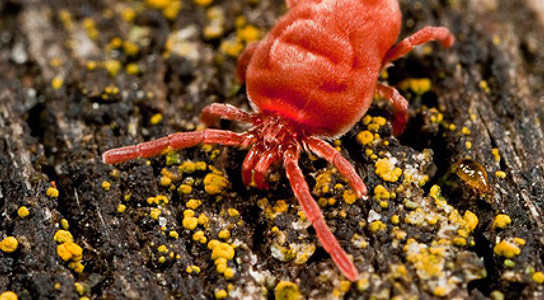
A new study of soil mites overturns the common assumption that evolution only occurs gradually over hundreds or thousands of years. Credit: University of Leeds
A new study led by scientists at the University of Leeds shows that short-term ecological change and evolution are intertwined and cannot reasonably be considered separate, finding that populations evolve rapidly in response to environmental change and population management.
Environmental change can drive hard-wired evolutionary changes in animal species in a matter of generations.
A University of Leeds-led study, published in the journal Ecology Letters, overturns the common assumption that evolution only occurs gradually over hundreds or thousands of years.
Instead, researchers found significant genetically transmitted changes in laboratory populations of soil mites in just 15 generations, leading to a doubling of the age at which the mites reached adulthood and large changes in population size. The results have important implications in areas such as disease and pest control, conservation, and fisheries management because they demonstrate that evolution can be a game-changer even in the short term.
Professor Tim Benton, of the University of Leeds’ Faculty of Biological Sciences, said: “This demonstrates that short-term ecological change and evolution are completely intertwined and cannot reasonably be considered separate. We found that populations evolve rapidly in response to environmental change and population management. This can have major consequences such as reducing harvesting yields or saving a population heading for extinction.”
Although previous research has implied a link between short-term changes in animal species’ physical characteristics and evolution, the Leeds-led study is the first to prove a causal relationship between rapid genetic evolution and animal population dynamics in a controlled experimental setting.
The researchers worked with soil mites that were collected from the wild and then raised in 18 glass tubes. Forty percent of adult mites were removed every week from six of the glass tubes. A similar proportion of juveniles were removed each week in a further six tubes, while no “harvesting” was conducted in the remaining third of the tubes.
Lead author Dr. Tom Cameron, a postdoctoral Fellow in the Faculty of Biological Sciences at Leeds at the time of the research and now based in Umeå University, Sweden, said: “We saw significant evolutionary changes relatively quickly. The age of maturity of the mites in the tubes doubled over about 15 generations, because they were competing in a different way than they would in the wild. Removing the adults caused them to remain as juveniles even longer because the genetics were responding to the high chance that they were going to die as soon as they matured. When they did eventually mature, they were so enormous they could lay all of their eggs very quickly.”
The initial change in the mites’ environment—from the wild into the laboratory—had a disastrous effect on the population, putting the mites on an extinction trajectory. However, in every population, including those subjected to the removal of adults or juveniles, the trajectory switched after only five generations of evolution and the population sizes began to increase.
The researchers found that the laboratory environment was selecting for those mites that grew more slowly. Under the competitive conditions in the tubes, the slow-growing mites were more fertile when they matured, meaning they could have more babies.
Dr. Cameron said: “The genetic evolution that resulted in an investment in egg production at the expense of individual growth rates led to population growth, rescuing the populations from extinction. This is evolutionary rescue in action and suggests that rapid evolution can help populations respond to rapid environmental change.”
Short-term ecological responses to the environment—for instance, a reduction in the size of adults because of a lack of food—and hard-wired evolutionary changes were separated by placing mites from different treatments into a similar environment for several generations and seeing whether differences persisted.
Professor Benton said: “The traditional idea would be that if you put animals in a new environment they stay basically the same but the way they grow changes because of variables like the amount of food. However, our study proves that the evolutionary effect— the change in the underlying biology in response to the environment—can happen at the same time as the ecological response. Ecology and evolution are intertwined,” he said.
Unpicking evolutionary change from ecological responses is particularly important in areas such as the management of fisheries, where human decisions can result in major changes to an entire population’s environment and life histories. The size at which cod in the North Sea mature is about half that of 50 years ago and this change has been linked to a collapse in the cod population because adult fish today are less fertile than their ancestors.
“The big debate has been over whether this is an evolutionary response to the way they are fished or whether this is, for instance, just the amount of food in the sea having a short-term ecological effect. Our study underlined that evolution can happen on a short timescale and even small 1 to 2 percent evolutionary changes in the underlying biology caused by your harvesting strategy can have major consequences on population growth and yields. You can’t just try to bring the environment back to what it was before and expect everything to return to normal,” Professor Benton said.
Reference: “Eco-evolutionary dynamics in response to selection on life-history” by Tom C. Cameron, Daniel O’Sullivan, Alan Reynolds, Stuart B. Piertney and Tim G. Benton, 8 April 2013, Ecology Letters.
DOI: 10.1111/ele.12107
The research was funded by the Natural Environment Research Council (NERC) and involved researchers from the University of Leeds and Professor Stuart Piertney of the University of Aberdeen’s School of Biological Sciences.









Adaption. Is this a surprise? The domestication of wolves into a vast array of dog breeds over a few hundred years is another example of how species contain a vast amount of adaptive range within their DNA. Evolutionary theory has maintained for a while that it takes billions of years but we have numerous examples of these changes happening quickly – if we look.
Mmm. I would think this would be common sense, and wasn’t it covered by Darwin? Since if the environement changes any species must adapt to the changes in order to survive. Is that not called Survival of the fittist? (sp) But why another Study was done on this I do not know. The same conclusion I thought was reached 50 or 60 years ago with regard to the demise of thousands of species like the Dinosaurs and Mastadons and thousands of other creatures, so is this study just another one in a long line of similar studies..Also instead of Mites they used Mice in similiar experiments in the 60’s. So what is new about this study? They used Mites instead of Mice? How about what goes on daily in over crowded cities like New York, London, Los Angeles, does this not happen eveyday there with people competing for food sources aka Money to buy food?.